
LINQ - SQL
LINQ to SQL offers an infrastructure (run-time) for the management of relational data as objects. It is a component of version 3.5 of the .NET Framework and ably does the translation of language-integrated queries of the object model into SQL. These queries are then sent to the database for the purpose of execution. After obtaining the results from the database, LINQ to SQL again translates them to objects.
Introduction of LINQ To SQL
For most ASP.NET developers, LINQ to SQL (also known as DLINQ) is an electrifying part of Language Integrated Query as this allows querying data in SQL server database by using usual LINQ expressions. It also allows to update, delete, and insert data, but the only drawback from which it suffers is its limitation to the SQL server database. However, there are many benefits of LINQ to SQL over ADO.NET like reduced complexity, few lines of coding and many more.
Below is a diagram showing the execution architecture of LINQ to SQL.
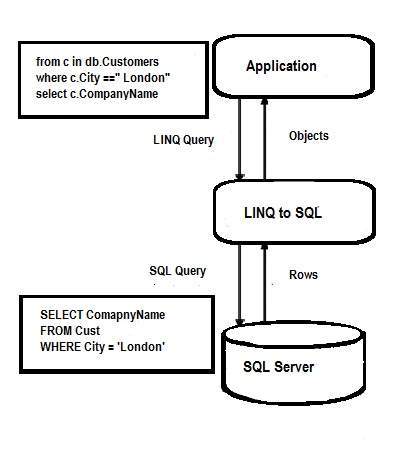
How to Use LINQ to SQL?
Step 1 − Make a new Data Connection with database server. View &arrar; Server Explorer &arrar; Data Connections &arrar; Add Connection
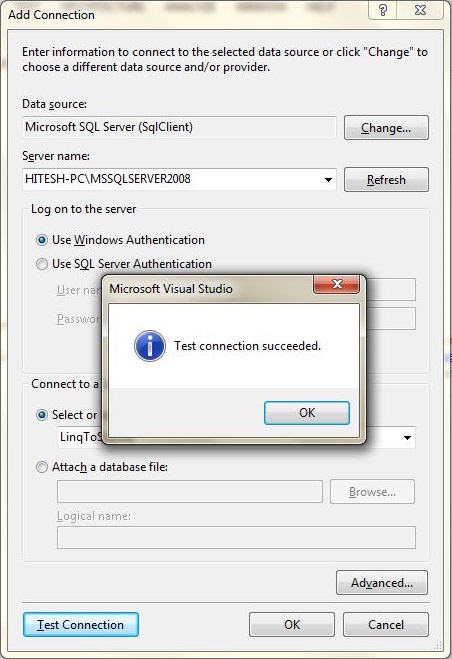
Step 2 − Add LINQ To SQL class file
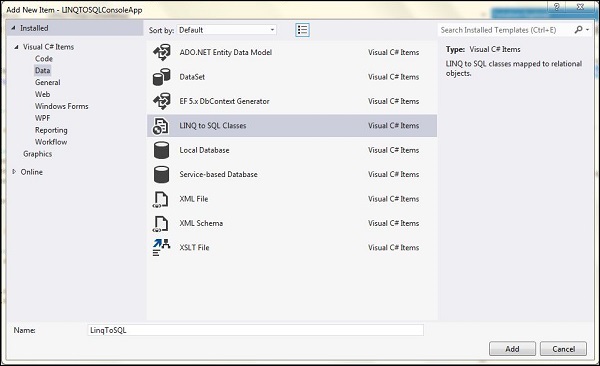
Step 3 − Select tables from database and drag and drop into the new LINQ to SQL class file.
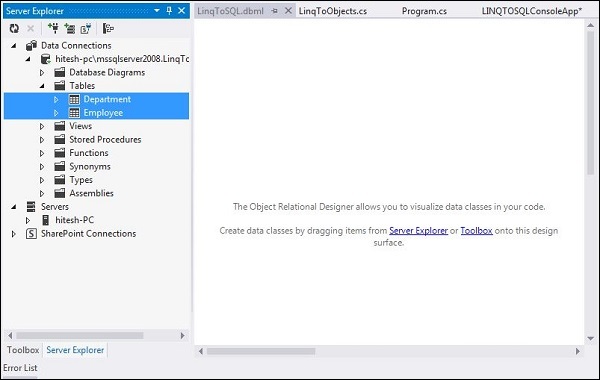
Step 4 − Added tables to class file.
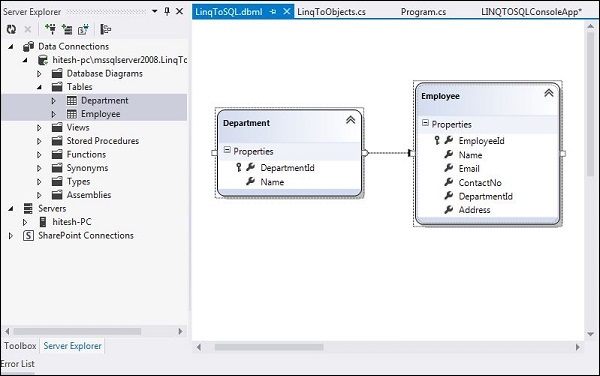
Querying with LINQ to SQL
The rules for executing a query with LINQ to SQL is similar to that of a standard LINQ query i.e. query is executed either deferred or immediate. There are various components that play a role in execution of a query with LINQ to SQL and these are the following ones.
LINQ to SQL API − requests query execution on behalf of an application and sent it to LINQ to SQL Provider.
LINQ to SQL Provider − converts query to Transact SQL(T-SQL) and sends the new query to the ADO Provider for execution.
ADO Provider − After execution of the query, send the results in the form of a DataReader to LINQ to SQL Provider which in turn converts it into a form of user object.
It should be noted that before executing a LINQ to SQL query, it is vital to connect to the data source via DataContext class.
Insert, Update and Delete using LINQ To SQL
Add OR Insert
C#
using System;
using System.Linq;
namespace LINQtoSQL {
class LinqToSQLCRUD {
static void Main(string[] args) {
string connectString = System.Configuration.ConfigurationManager.ConnectionStrings["LinqToSQLDBConnectionString"].ToString();
LinqToSQLDataContext db = new LinqToSQLDataContext(connectString);
//Create new Employee
Employee newEmployee = new Employee();
newEmployee.Name = "Michael";
newEmployee.Email = "yourname@companyname.com";
newEmployee.ContactNo = "343434343";
newEmployee.DepartmentId = 3;
newEmployee.Address = "Michael - USA";
//Add new Employee to database
db.Employees.InsertOnSubmit(newEmployee);
//Save changes to Database.
db.SubmitChanges();
//Get new Inserted Employee
Employee insertedEmployee = db.Employees.FirstOrDefault(e ⇒e.Name.Equals("Michael"));
Console.WriteLine("Employee Id = {0} , Name = {1}, Email = {2}, ContactNo = {3}, Address = {4}",
insertedEmployee.EmployeeId, insertedEmployee.Name, insertedEmployee.Email,
insertedEmployee.ContactNo, insertedEmployee.Address);
Console.WriteLine("\nPress any key to continue.");
Console.ReadKey();
}
}
}
VB
Module Module1
Sub Main()
Dim connectString As String = System.Configuration.ConfigurationManager.ConnectionStrings("LinqToSQLDBConnectionString").ToString()
Dim db As New LinqToSQLDataContext(connectString)
Dim newEmployee As New Employee()
newEmployee.Name = "Michael"
newEmployee.Email = "yourname@companyname.com"
newEmployee.ContactNo = "343434343"
newEmployee.DepartmentId = 3
newEmployee.Address = "Michael - USA"
db.Employees.InsertOnSubmit(newEmployee)
db.SubmitChanges()
Dim insertedEmployee As Employee = db.Employees.FirstOrDefault(Function(e) e.Name.Equals("Michael"))
Console.WriteLine("Employee Id = {0} , Name = {1}, Email = {2}, ContactNo = {3},
Address = {4}", insertedEmployee.EmployeeId, insertedEmployee.Name,
insertedEmployee.Email, insertedEmployee.ContactNo, insertedEmployee.Address)
Console.WriteLine(vbLf & "Press any key to continue.")
Console.ReadKey()
End Sub
End Module
When the above code of C# or VB is compiled and run, it produces the following result −
Emplyee ID = 4, Name = Michael, Email = yourname@companyname.com, ContactNo = 343434343, Address = Michael - USA Press any key to continue.
Update
C#
using System;
using System.Linq;
namespace LINQtoSQL {
class LinqToSQLCRUD {
static void Main(string[] args) {
string connectString = System.Configuration.ConfigurationManager.ConnectionStrings["LinqToSQLDBConnectionString"].ToString();
LinqToSQLDataContext db = new LinqToSQLDataContext(connectString);
//Get Employee for update
Employee employee = db.Employees.FirstOrDefault(e =>e.Name.Equals("Michael"));
employee.Name = "George Michael";
employee.Email = "yourname@companyname.com";
employee.ContactNo = "99999999";
employee.DepartmentId = 2;
employee.Address = "Michael George - UK";
//Save changes to Database.
db.SubmitChanges();
//Get Updated Employee
Employee updatedEmployee = db.Employees.FirstOrDefault(e ⇒e.Name.Equals("George Michael"));
Console.WriteLine("Employee Id = {0} , Name = {1}, Email = {2}, ContactNo = {3}, Address = {4}",
updatedEmployee.EmployeeId, updatedEmployee.Name, updatedEmployee.Email,
updatedEmployee.ContactNo, updatedEmployee.Address);
Console.WriteLine("\nPress any key to continue.");
Console.ReadKey();
}
}
}
VB
Module Module1
Sub Main()
Dim connectString As String = System.Configuration.ConfigurationManager.ConnectionStrings("LinqToSQLDBConnectionString").ToString()
Dim db As New LinqToSQLDataContext(connectString)
Dim employee As Employee = db.Employees.FirstOrDefault(Function(e) e.Name.Equals("Michael"))
employee.Name = "George Michael"
employee.Email = "yourname@companyname.com"
employee.ContactNo = "99999999"
employee.DepartmentId = 2
employee.Address = "Michael George - UK"
db.SubmitChanges()
Dim updatedEmployee As Employee = db.Employees.FirstOrDefault(Function(e) e.Name.Equals("George Michael"))
Console.WriteLine("Employee Id = {0} , Name = {1}, Email = {2}, ContactNo = {3},
Address = {4}", updatedEmployee.EmployeeId, updatedEmployee.Name,
updatedEmployee.Email, updatedEmployee.ContactNo, updatedEmployee.Address)
Console.WriteLine(vbLf & "Press any key to continue.")
Console.ReadKey()
End Sub
End Module
When the above code of C# or Vb is compiled and run, it produces the following result −
Emplyee ID = 4, Name = George Michael, Email = yourname@companyname.com, ContactNo = 999999999, Address = Michael George - UK Press any key to continue.
Delete
C#
using System;
using System.Linq;
namespace LINQtoSQL {
class LinqToSQLCRUD {
static void Main(string[] args) {
string connectString = System.Configuration.ConfigurationManager.ConnectionStrings["LinqToSQLDBConnectionString"].ToString();
LinqToSQLDataContext db = newLinqToSQLDataContext(connectString);
//Get Employee to Delete
Employee deleteEmployee = db.Employees.FirstOrDefault(e ⇒e.Name.Equals("George Michael"));
//Delete Employee
db.Employees.DeleteOnSubmit(deleteEmployee);
//Save changes to Database.
db.SubmitChanges();
//Get All Employee from Database
var employeeList = db.Employees;
foreach (Employee employee in employeeList) {
Console.WriteLine("Employee Id = {0} , Name = {1}, Email = {2}, ContactNo = {3}",
employee.EmployeeId, employee.Name, employee.Email, employee.ContactNo);
}
Console.WriteLine("\nPress any key to continue.");
Console.ReadKey();
}
}
}
VB
Module Module1
Sub Main()
Dim connectString As String = System.Configuration.ConfigurationManager.ConnectionStrings("LinqToSQLDBConnectionString").ToString()
Dim db As New LinqToSQLDataContext(connectString)
Dim deleteEmployee As Employee = db.Employees.FirstOrDefault(Function(e) e.Name.Equals("George Michael"))
db.Employees.DeleteOnSubmit(deleteEmployee)
db.SubmitChanges()
Dim employeeList = db.Employees
For Each employee As Employee In employeeList
Console.WriteLine("Employee Id = {0} , Name = {1}, Email = {2}, ContactNo = {3}",
employee.EmployeeId, employee.Name, employee.Email, employee.ContactNo)
Next
Console.WriteLine(vbLf & "Press any key to continue.")
Console.ReadKey()
End Sub
End Module
When the above code of C# or VB is compiled and run, it produces the following result −
Emplyee ID = 1, Name = William, Email = abc@gy.co, ContactNo = 999999999 Emplyee ID = 2, Name = Miley, Email = amp@esds.sds, ContactNo = 999999999 Emplyee ID = 3, Name = Benjamin, Email = asdsad@asdsa.dsd, ContactNo = Press any key to continue.